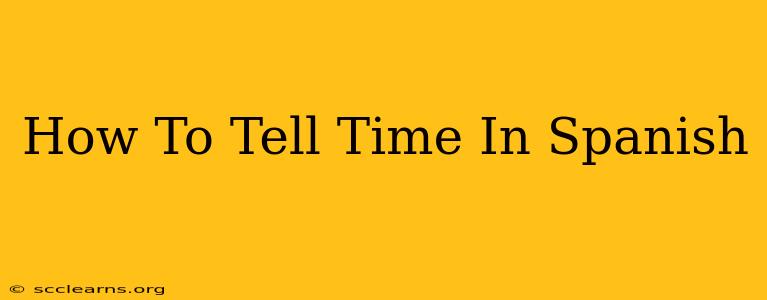Learning to tell time in Spanish is a valuable skill for anyone studying the language. Whether you're planning a trip to a Spanish-speaking country or simply expanding your linguistic abilities, mastering this aspect of the language will significantly enhance your communication skills. This guide provides a comprehensive overview of how to tell time in Spanish, covering various time expressions and offering practical examples to help you confidently navigate time-related conversations.
Understanding the Basics: Telling the Hour
The foundation of telling time in Spanish lies in understanding the numbers and their application. The hours 1-12 are relatively straightforward, mirroring their English counterparts:
- 1: uno
- 2: dos
- 3: tres
- 4: cuatro
- 5: cinco
- 6: seis
- 7: siete
- 8: ocho
- 9: nueve
- 10: diez
- 11: once
- 12: doce
To express the time, you use the verb ser (to be) followed by the hour. For example:
- It's one o'clock: Es la una. (Note the use of "la una" for one o'clock. This is a special case.)
- It's two o'clock: Son las dos. (Note the use of "son las" for hours 2-12. "Son" is the plural form of "es".)
- It's three o'clock: Son las tres.
- It's twelve o'clock: Son las doce.
Telling the Minutes: Beyond the Hour
Once you've grasped the basics of telling the hour, understanding how to express minutes is the next step. Spanish uses a slightly different system than English, making it crucial to learn the correct phrasing.
Minutes 1-30: Using "y" (and)
For minutes between 1 and 30, use the preposition "y" (and) to connect the minutes to the hour.
- It's 1:15: Es la una y cuarto. (A quarter past one)
- It's 2:20: Son las dos y veinte. (Twenty past two)
- It's 3:30: Son las tres y media. (Half past three - note the use of "media")
Minutes 31-60: Using "menos" (less)
For minutes between 31 and 60, use the preposition "menos" (less) to indicate the minutes remaining until the next hour.
- It's 4:35: Son las cinco menos veinticinco. (Twenty-five to five)
- It's 5:40: Son las seis menos veinte. (Twenty to six)
- It's 6:55: Son las siete menos cinco. (Five to seven)
Using AM and PM (a.m. and p.m.): Morning and Afternoon
While not strictly necessary for everyday conversations, especially in casual settings, understanding how to specify AM and PM is helpful for clarity. Spanish uses "de la mañana" (of the morning), "de la tarde" (of the afternoon), "de la noche" (of the night), and "de la madrugada" (of the early morning/dawn) to indicate the time of day.
- It's 7:00 AM: Son las siete de la mañana.
- It's 3:00 PM: Son las tres de la tarde.
- It's 11:00 PM: Son las once de la noche.
- It's 3:00 AM: Son las tres de la madrugada.
Practice Makes Perfect!
The best way to master telling time in Spanish is through consistent practice. Try using these phrases in conversation, and don't be afraid to make mistakes! Each attempt brings you closer to fluency. Use online resources, language exchange partners, and even Spanish-language TV shows or movies to reinforce your learning. With dedication and practice, you'll be telling time in Spanish like a native speaker in no time. ¡Buena suerte! (Good luck!)

